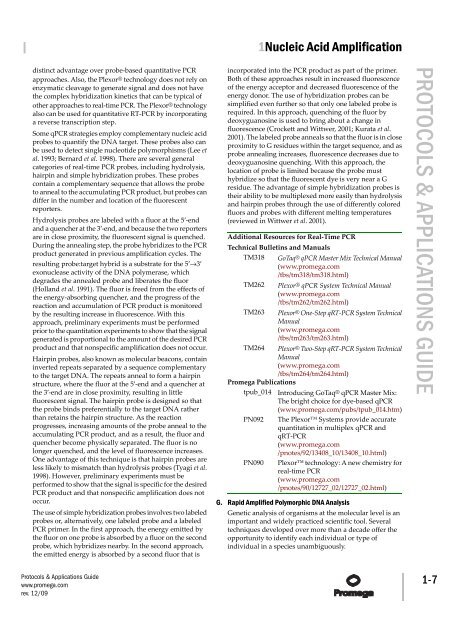Protocols and Applications Guide (US Letter Size) - Promega
Protocols and Applications Guide (US Letter Size) - Promega
Protocols and Applications Guide (US Letter Size) - Promega
Create successful ePaper yourself
Turn your PDF publications into a flip-book with our unique Google optimized e-Paper software.
| 1Nucleic Acid Amplification<br />
distinct advantage over probe-based quantitative PCR<br />
approaches. Also, the Plexor® technology does not rely on<br />
enzymatic cleavage to generate signal <strong>and</strong> does not have<br />
the complex hybridization kinetics that can be typical of<br />
other approaches to real-time PCR. The Plexor® technology<br />
also can be used for quantitative RT-PCR by incorporating<br />
a reverse transcription step.<br />
Some qPCR strategies employ complementary nucleic acid<br />
probes to quantify the DNA target. These probes also can<br />
be used to detect single nucleotide polymorphisms (Lee et<br />
al. 1993; Bernard et al. 1998). There are several general<br />
categories of real-time PCR probes, including hydrolysis,<br />
hairpin <strong>and</strong> simple hybridization probes. These probes<br />
contain a complementary sequence that allows the probe<br />
to anneal to the accumulating PCR product, but probes can<br />
differ in the number <strong>and</strong> location of the fluorescent<br />
reporters.<br />
Hydrolysis probes are labeled with a fluor at the 5′-end<br />
<strong>and</strong> a quencher at the 3′-end, <strong>and</strong> because the two reporters<br />
are in close proximity, the fluorescent signal is quenched.<br />
During the annealing step, the probe hybridizes to the PCR<br />
product generated in previous amplification cycles. The<br />
resulting probe:target hybrid is a substrate for the 5′→3′<br />
exonuclease activity of the DNA polymerase, which<br />
degrades the annealed probe <strong>and</strong> liberates the fluor<br />
(Holl<strong>and</strong> et al. 1991). The fluor is freed from the effects of<br />
the energy-absorbing quencher, <strong>and</strong> the progress of the<br />
reaction <strong>and</strong> accumulation of PCR product is monitored<br />
by the resulting increase in fluorescence. With this<br />
approach, preliminary experiments must be performed<br />
prior to the quantitation experiments to show that the signal<br />
generated is proportional to the amount of the desired PCR<br />
product <strong>and</strong> that nonspecific amplification does not occur.<br />
Hairpin probes, also known as molecular beacons, contain<br />
inverted repeats separated by a sequence complementary<br />
to the target DNA. The repeats anneal to form a hairpin<br />
structure, where the fluor at the 5′-end <strong>and</strong> a quencher at<br />
the 3′-end are in close proximity, resulting in little<br />
fluorescent signal. The hairpin probe is designed so that<br />
the probe binds preferentially to the target DNA rather<br />
than retains the hairpin structure. As the reaction<br />
progresses, increasing amounts of the probe anneal to the<br />
accumulating PCR product, <strong>and</strong> as a result, the fluor <strong>and</strong><br />
quencher become physically separated. The fluor is no<br />
longer quenched, <strong>and</strong> the level of fluorescence increases.<br />
One advantage of this technique is that hairpin probes are<br />
less likely to mismatch than hydrolysis probes (Tyagi et al.<br />
1998). However, preliminary experiments must be<br />
performed to show that the signal is specific for the desired<br />
PCR product <strong>and</strong> that nonspecific amplification does not<br />
occur.<br />
The use of simple hybridization probes involves two labeled<br />
probes or, alternatively, one labeled probe <strong>and</strong> a labeled<br />
PCR primer. In the first approach, the energy emitted by<br />
the fluor on one probe is absorbed by a fluor on the second<br />
probe, which hybridizes nearby. In the second approach,<br />
the emitted energy is absorbed by a second fluor that is<br />
<strong>Protocols</strong> & <strong>Applications</strong> <strong>Guide</strong><br />
www.promega.com<br />
rev. 12/09<br />
incorporated into the PCR product as part of the primer.<br />
Both of these approaches result in increased fluorescence<br />
of the energy acceptor <strong>and</strong> decreased fluorescence of the<br />
energy donor. The use of hybridization probes can be<br />
simplified even further so that only one labeled probe is<br />
required. In this approach, quenching of the fluor by<br />
deoxyguanosine is used to bring about a change in<br />
fluorescence (Crockett <strong>and</strong> Wittwer, 2001; Kurata et al.<br />
2001). The labeled probe anneals so that the fluor is in close<br />
proximity to G residues within the target sequence, <strong>and</strong> as<br />
probe annealing increases, fluorescence decreases due to<br />
deoxyguanosine quenching. With this approach, the<br />
location of probe is limited because the probe must<br />
hybridize so that the fluorescent dye is very near a G<br />
residue. The advantage of simple hybridization probes is<br />
their ability to be multiplexed more easily than hydrolysis<br />
<strong>and</strong> hairpin probes through the use of differently colored<br />
fluors <strong>and</strong> probes with different melting temperatures<br />
(reviewed in Wittwer et al. 2001).<br />
Additional Resources for Real-Time PCR<br />
Technical Bulletins <strong>and</strong> Manuals<br />
TM318 GoTaq® qPCR Master Mix Technical Manual<br />
(www.promega.com<br />
/tbs/tm318/tm318.html)<br />
TM262 Plexor® qPCR System Technical Manual<br />
(www.promega.com<br />
/tbs/tm262/tm262.html)<br />
TM263 Plexor® One-Step qRT-PCR System Technical<br />
Manual<br />
(www.promega.com<br />
/tbs/tm263/tm263.html)<br />
TM264 Plexor® Two-Step qRT-PCR System Technical<br />
Manual<br />
(www.promega.com<br />
/tbs/tm264/tm264.html)<br />
<strong>Promega</strong> Publications<br />
tpub_014 Introducing GoTaq® qPCR Master Mix:<br />
The bright choice for dye-based qPCR<br />
(www.promega.com/pubs/tpub_014.htm)<br />
PN092 The Plexor Systems provide accurate<br />
quantitation in multiplex qPCR <strong>and</strong><br />
qRT-PCR<br />
(www.promega.com<br />
/pnotes/92/13408_10/13408_10.html)<br />
PN090 Plexor technology: A new chemistry for<br />
real-time PCR<br />
(www.promega.com<br />
/pnotes/90/12727_02/12727_02.html)<br />
G. Rapid Amplified Polymorphic DNA Analysis<br />
Genetic analysis of organisms at the molecular level is an<br />
important <strong>and</strong> widely practiced scientific tool. Several<br />
techniques developed over more than a decade offer the<br />
opportunity to identify each individual or type of<br />
individual in a species unambiguously.<br />
PROTOCOLS & APPLICATIONS GUIDE 1-7
















